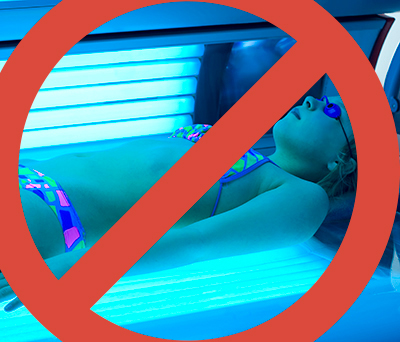
Your teenage daughter is headed to the beach for a mid-winter break and she wants to get a start on her tan at the neighborhood tanning salon. For the sake of her health, just say no!
Winter might seem like the ideal time to try a tanning bed to get a little color – but that tan can turn deadly in the future.
Lynn Cornelius, MD, chief of the division of dermatology and the Winfred A. and Emma R. Showman Professor in Dermatology at Washington University explains, “Ultraviolet light exposure is directly linked to the development of skin cancer, including melanoma, the most deadliest form – killing nearly 10,000 people a year. In fact, the ultraviolet exposure received from tanning beds can be 5 – 15 times greater than summer mid-day sun.”
Damage from ultraviolet exposure is immediate, and the skin’s response is ether burning, or in some individuals, “tanning” as a response to the DNA damage incurred. The cellular damage is also cumulative and therefore it may take a decade or longer for someone who has been exposed to tanning beds to develop a skin cancer. To that point, exposure at a younger age presents a particular risk.
Dr. Cornelius says, “Missouri has no minimum age restrictions banning tanning bed use. In 2014, legislation was passed requiring a consent form to be signed by a parent for teens under the age of 17. Studies have shown that parental consent laws are not an effective mechanism to reduce teen tanning. With the absence of effective legislation, we are failing to protect our children, who are at an increased risk of developing skin cancer when exposed to the high-intensity levels of ultraviolet light that can be received in a tanning bed.
We see a lot of young women in their 20s who have used tanning beds, some who began tanning as young as age 15, with melanoma, some in the advanced stages. It has become the second-most common form of cancer for adolescents and young adults ages 15-29. It is unnerving –ultraviolet light exposure is the primary modifiable risk factor for skin cancer – tanning beds are a completely avoidable cancer risk.”
Indoor tanning facts that will surprise you
Skin cancer rates are on the rise in Missouri
The rate of melanoma in Missouri has doubled in the last nine years. Nationwide, skin cancer is the most commonly diagnosed cancer and rates have been rising for the past 30 years. This should serve as a wake-up call for lawmakers in Missouri and other states that don’t regulate tanning beds.
Youth tanning rates in Missouri are almost double the national average
In Missouri, 21 percent of girls in 11th grade and 30 percent of girls in 12th grade have used an indoor tanning device (compared to a nationwide rate of 16 percent for girls in the 12th grade).
Of the estimated 11.3 million Americans who tan indoors every year, approximately 1.6 million are adolescents.
Indoor tanning devices are carcinogenic to humans
The greatest avoidable known risk factor for skin cancer is the use of indoor tanning devices. Tanning before the age of 35 increases the risk of melanoma by 59 percent, squamous cell carcinoma by 67 percent and basal cell carcinoma by 29 percent. Rates increase even more when tanning devices are used before age 25.
Missouri’s current law is inadequate, and our kids deserve better protection
To protect youth from the harmful effects of artificial UV radiation, Missouri law needs to be changed to prohibit the use of indoor tanning devices for children under age 18.
Additionally, people over age 18 who use tanning beds need to be informed of the dangers and required to sign a waiver to acknowledge the serious risk of indoor tanning.
Dr. Cornelius says, “It is plain and simple – indoor tanning causes cancer. We need to protect our kids – tanning is like smoking. Neither is safe, both are cancer-causing.”
To make an appointment with a Washington University dermatologist, please call 314-362-2643.
Barnes-Jewish Center for Outpatient Health
4901 Forest Park Avenue, Suite 502
St. Louis, MO 63108